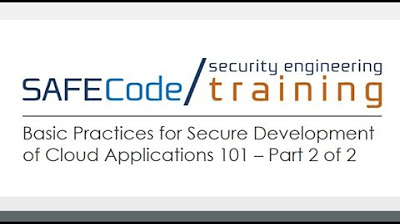Malicious Updates - CompTIA Security+ SY0-701 - 2.3
Summary
TLDRThis script emphasizes the importance of keeping operating systems and applications updated to prevent security vulnerabilities. It advises best practices for updates, such as having backups and ensuring trusted sources. However, it also highlights the risk of malicious code in updates, using the SolarWinds Orion incident as an example of how attackers can exploit trusted update processes to distribute malware, even with digital signatures, to major organizations.
Takeaways
- 🛡️ Always keep your operating systems and applications updated to avoid vulnerabilities from older code.
- 🔍 Be cautious of potential malicious software in applications and updates, as attackers could embed their code within them.
- 💾 Maintain a backup before making any system changes to revert back in case of update failure.
- 🔒 Ensure updates come from trusted sources to prevent the installation of malicious updates.
- 🔄 Updates are similar to installing new applications, so verify the legitimacy of update prompts, especially if they appear unexpectedly.
- 🌐 Check the source of downloaded update files and understand the implications of performing the update.
- 🔑 Prefer downloading updates directly from the application developer's site for higher trust in the update's legitimacy.
- ✅ Many operating systems require digital signatures for application installation, providing a level of trust in the update's authenticity.
- 🔄 Some applications have built-in update processes with security checks and digital signatures, enhancing trust in the update.
- 🚨 The SolarWinds Orion incident in 2020 demonstrates that even trusted update processes can be compromised, showing the importance of vigilance.
- 🔒 Despite digital signatures and internal processes, there's no 100% guarantee of an update's legitimacy, emphasizing the need for continuous security practices.
Q & A
Why is it important to keep operating systems and applications updated?
-Keeping operating systems and applications updated is crucial to avoid vulnerabilities and security problems associated with older code. Updates often include patches for known security issues, helping to protect against potential threats.
What concerns arise when installing applications or updates?
-There is a concern that applications or updates might contain malicious software. Attackers could potentially embed their malicious code within the update, which can compromise the system if installed.
What are some best practices associated with the update process?
-Best practices include having a backup before making any changes, ensuring the update sources are trusted, and verifying the legitimacy of update messages, especially if they appear unexpectedly during web browsing.
Why is it recommended to have a backup before updating a system?
-A backup ensures that if something goes wrong during the update process, you can revert to the previous configuration, minimizing downtime and potential data loss.
How can you determine if the source of an update is trusted?
-You can determine a trusted source by checking if the software update is coming from a commonly used source or one that is officially associated with the application in question.
What does the message from the Chrome browser about updating signify?
-The message indicates that the user is using an older version of the browser and prompts them to update for smooth and secure operation. It suggests that the download will begin automatically or provides a link to start the update.
How can you assess the legitimacy of an update message that appears during web browsing?
-Assess the legitimacy by considering the context in which the message appears. If it appears unexpectedly while browsing, it may not be legitimate and should be checked further before proceeding.
What precautions should be taken when downloading updates from third-party websites?
-Ensure that the source is trusted by verifying it is a site that commonly hosts such patches. Be aware of the potential risks and understand the implications of performing the update.
What role do digital signatures play in the update process?
-Digital signatures, provided by the application developer and validated by the operating system, serve as a verification method to ensure that the update is legitimate and has not been tampered with.
How does an application's built-in update process contribute to security?
-A built-in update process usually includes security checks and digital signatures, which help verify the authenticity of the update, reducing the risk of installing malicious software.
What was the SolarWinds Orion incident, and what lessons can be learned from it?
-The SolarWinds Orion incident in December 2020 involved attackers gaining access to the development system and embedding malicious code into legitimate updates, which were then distributed to users. The lesson is that even trusted processes can be compromised, emphasizing the need for continuous vigilance and security practices.
Outlines

Cette section est réservée aux utilisateurs payants. Améliorez votre compte pour accéder à cette section.
Améliorer maintenantMindmap

Cette section est réservée aux utilisateurs payants. Améliorez votre compte pour accéder à cette section.
Améliorer maintenantKeywords

Cette section est réservée aux utilisateurs payants. Améliorez votre compte pour accéder à cette section.
Améliorer maintenantHighlights

Cette section est réservée aux utilisateurs payants. Améliorez votre compte pour accéder à cette section.
Améliorer maintenantTranscripts

Cette section est réservée aux utilisateurs payants. Améliorez votre compte pour accéder à cette section.
Améliorer maintenantVoir Plus de Vidéos Connexes

Operating System Vulnerabilities - CompTIA Security+ SY0-701 - 2.3

CompTIA Security+ Full Course: Security Assessments and Vulnerabilities

SAFECode Basic Practices for Secure Development of Cloud Applications 101 Quiz Part 2 p1

Розділ 16: Основи мережної безпеки CCNA-1

10 Mistakes Android Users Make !!

Penetration Tests - CompTIA Security+ SY0-701 - 5.5
5.0 / 5 (0 votes)
